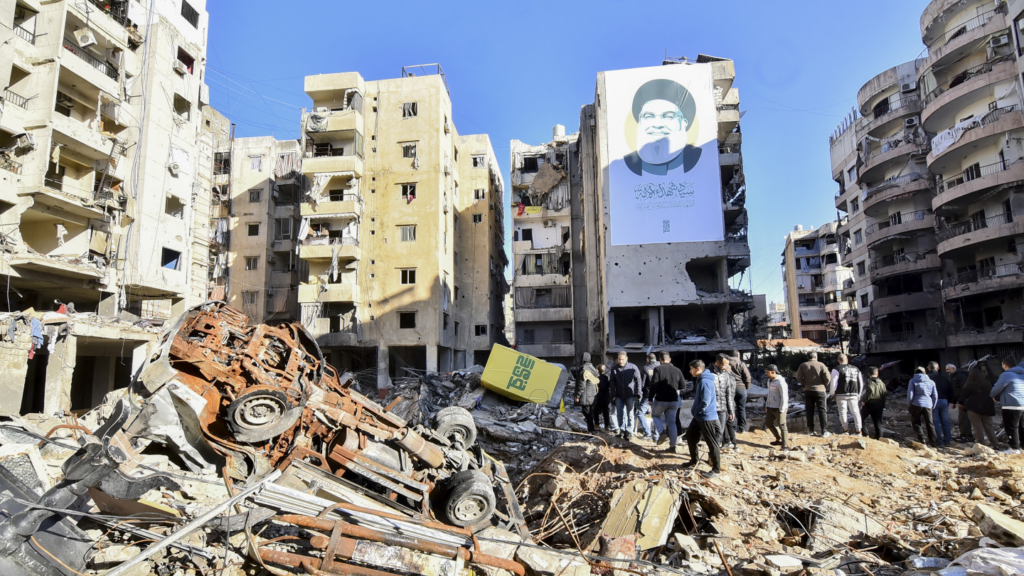
In-depth: From Beirut’s razed downtown to reconstructing its southern suburbs, war in Lebanon has long served as a pretext for elite-led urban transformation.
Lebanon, reeling from a war that inflicted an estimated $5.1 billion in economic losses, now faces the daunting task of reconstruction.
With physical damages requiring an estimated $11 billion in funding, the state is struggling to secure international support amid a deep governance crisis.
But according to experts, other challenges persist as past patterns loom large: reconstruction efforts risk once again becoming vehicles for political and economic control, rather than genuine public recovery.
In a small, rented apartment in Beirut, Amin Al-Hajj’s hopes of returning to Al-Zalloutieh, his town in southern Lebanon, are thinning by the day. His three-story home was flattened by Israel’s bombing, and he has since been living far from his community and customs.
“My entire house was destroyed. I can’t even return to my village – we were scattered into areas we don’t know, among people we don’t know, with no hope of going back,” Amin told The New Arab.
Under the pretext of reconstruction that followed Lebanon’s civil war, and which focused on Beirut’s centre, Ahmad Mwassi, now in his 60s, was one of many former residents forced out of their homes at the time, never to return.
“Armed security personnel made me sign a paper giving up my home, which hadn’t even been damaged” by the 15-year conflict, he recalls. “They threatened to jail me for attacking the authorities if I refused. After the war, everyone had weapons – it was an easy charge to make.”
While the majority of the million people who were displaced by the Israel-Hezbollah war have returned to their villages, thousands of families have not. For those, the trauma of displacement is compounded by uncertainty over whether they will ever return.
With state institutions crippled, fears are mounting that reconstruction will follow the path of earlier conflicts – led by private interests or partisan actors, rather than public need.
After the civil war: Beirut’s downtown becomes a business district
The post-war experience of Beirut’s historic downtown offers a stark precedent. In the 1990s, vast sections of central Beirut were bulldozed in the name of redevelopment. Tala Aladdin, an urban researcher and architect at Public Works Studio, says the reconstruction was spearheaded by Solidere, a private company granted exceptional legal and property rights under Law 117.
“Solidere presented the wartime destruction as justification for a radical transformation of the area, not just restoration,” Aladdin explained to TNA. “They framed old, damaged buildings as obstacles to their vision of a ‘New Beirut’ – a regional hub for commerce and luxury.”
In practice, the company’s approach displaced long-time residents, like Mwassi, and erased traditional markets in favour of international brands, upscale malls, and high-end real estate.
“The result was a neoliberal redevelopment model that prioritised private investment over the city’s social and economic fabric,” she says. “It isolated downtown from the rest of Beirut, reproducing the very divisions created by war.”
According to a 2018 research paper, author Deen Sharp wrote that the reconstruction that was implemented in the 1990s can be traced back to 1977. The broader historical horizon of the reconstruction “was responsible for not only the extensive destruction of the built environment but also for the continuation of certain types of conflict and extraction of social wealth,” the paper said.
“The choice, means, and method by which particular infrastructure, housing, government and financial institutions, were reconstituted and reconstructed was of profound economic and sociopolitical importance to competing factions both within and outside Lebanon,” the paper added.
“For example, the enclaved Beirut that emerged in the Civil War years was not only a result of the destruction of the built environment but also its re-formulation through construction during wartime. Militias used the provision of basic urban services as a strategy of control and intimidation of both their ‘own’ population and ‘others’.”
2006 war: Reconstruction as political consolidation
A similar pattern emerged after the 2006 war Israel waged on Lebanon, when much of the destruction was concentrated in Hezbollah strongholds in the southern suburbs of Beirut and in the south and Bekaa. Damages, which were estimated at $5.3 billion, were largely handled by Hezbollah, which moved swiftly to take charge of rebuilding, amidst the absence of a coherent state-led response.
Through its affiliated group, Jihad al-Binaa, the party launched the “Waad” (Promise) project, which pledged to restore the affected areas “better than they were”. The organisation collected compensation funds allocated by the state and covered any additional costs. The primary goal, according to Tala Aladdin, was to preserve “demographic stability” and enable swift reconstruction so residents could return.
Within five years, most residents were back. But the process, she notes, entrenched Hezbollah’s influence in the area. “This was a reconstruction model that depended on foreign financing and political control of urban space. It deepened the hold of political actors over communities and bypassed state institutions entirely.”
Architect and former Engineers Syndicate head Jad Tabet calls it “an unusual model” compared to traditional reconstruction processes, which rely on public institutions or private capital. He likens it to post-WWII policies in communist parts of France and Italy, where parties used urban planning to consolidate their presence in working-class districts. “It created parallel governance,” he says.
This time, Hezbollah emerges from the 14-month war significantly weakened. The group has lost several top leaders to Israeli airstrikes and is grappling with a drastically changed regional and global landscape. For the first time, it appears unable to fulfil its longstanding role as a provider and protector in the south, where much of its core support base resides.
Nahr al-Bared: Security takes precedence over return
The Palestinian refugee camp of Nahr al-Bared in north Lebanon presents a different kind of case. Destroyed in 2007 during heavy fighting between the Lebanese army and the armed group Fatah al-Islam, the camp’s reconstruction has dragged on for nearly two decades.
Established in 1949, Nahr al-Bared faced legal complications after its destruction. Palestinians are barred from owning property in Lebanon, and after the fighting ended, the Lebanese government commissioned a consultancy to design a new master plan that met military priorities.
“The focus was on security – widening roads to allow army vehicles access, for example,” says Aladdin. That came at the expense of recreating the camp’s original urban character.
By late 2023, only 4,181 families had returned out of nearly 5,000, according to UNRWA. Rebuilding has been hampered by slow funding and the lack of official maps or ownership documents. In response, residents formed a reconstruction committee that gathered stories, drawings, and descriptions of the destroyed neighbourhood, detailing home layouts, building heights, and alleyways, to help reconstruct their urban memory in the absence of formal records.
Yet the heavy security presence has led many to leave again. “There are fences, checkpoints, daily inspections,” says Abdullah (a pseudonym), who chose to live outside the camp. “After so much death and displacement, I can’t go through that again. For me, going back is impossible.”
Whether in Beirut’s downtown, Hezbollah’s southern strongholds, or a Palestinian refugee camp, experts say that post-war reconstruction in Lebanon has often reflected the interests of those in power – political parties, private companies, or military actors – rather than the needs of affected communities.
In the absence of a strong, transparent state, each group has used the moment of destruction to remake territory in its image. Entire neighbourhoods have been reimagined, not to restore what was lost, but to assert control – economically, demographically, or politically.
Mwassi, who has been living in Beirut’s suburbs since being displaced, has avoided visiting the capital’s centre for two decades. At the age of 15 at the time, he had been shot during the war by warring militants and was then forced out of his home by the same factions.
“When I finally went to that part of Beirut, I wept like the child I was when I left. It bore no resemblance to my childhood home. I did not feel connected to it at all. It breaks my heart to see my country shaped and reshaped by the interests of groups, and not its people”.
